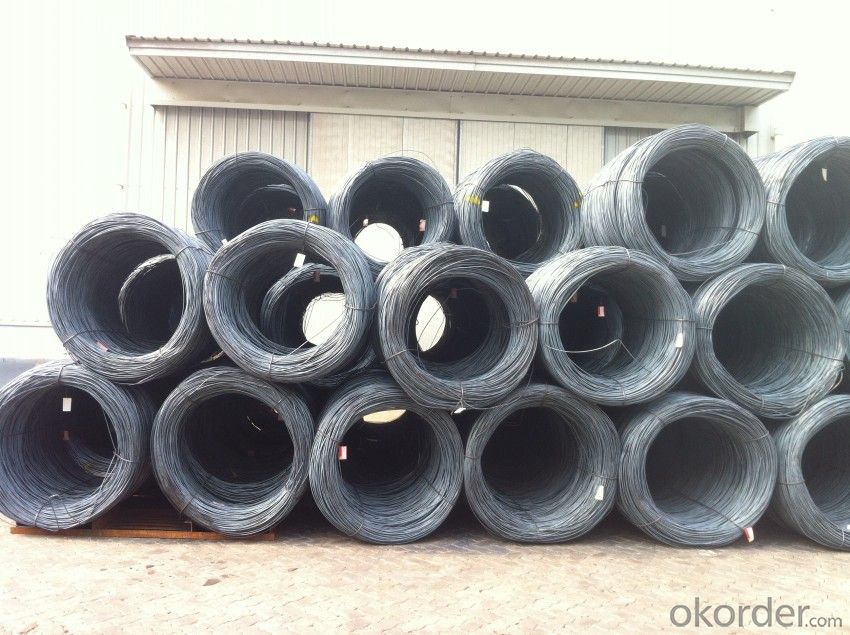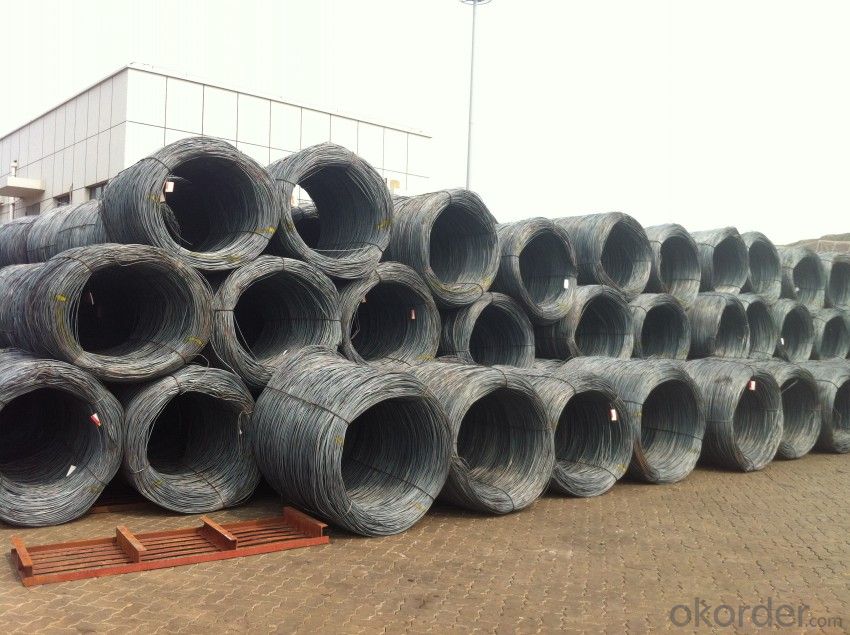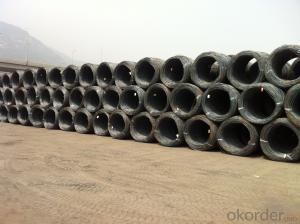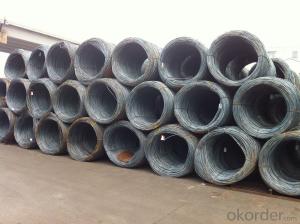Hot Rolled SAE1008 Wire Rods with High Quality
- Loading Port:
- Tianjin
- Payment Terms:
- TT OR LC
- Min Order Qty:
- 25 m.t
- Supply Capability:
- 10000 m.t/month
OKorder Service Pledge
OKorder Financial Service
You Might Also Like
Item specifice
OKorder is offering SAE1008 Wire Rods at great prices with worldwide shipping. Our supplier is a world-class manufacturer of steel, with our products utilized the world over. OKorder annually supplies products to European, North American and Asian markets. We provide quotations within 24 hours of receiving an inquiry and guarantee competitive prices.
Product Applications:
After hot-rolled the products shaped into coil and delivery as finished product, including round, square, rectangular, hexagonal and so on. Since most of the products are round, it is generally called wire rod. Carbon steel wire rod is widely used in construction and manufacturing. Carbon steel wire rod is mainly used for reinforcement of reinforced concrete and welded structure or reprocessed (roberts , nail, etc.) materials, especially used to produce wire drawing, welding electrode, nails, spring, electronic, precise machinery parts and so on.
Product Advantages:
OKorder's Wire Rods are durable, strong, and resist corrosion.
Main Product Features:
· Premium quality
· Prompt delivery & seaworthy packing (30 days after receiving deposit)
· Corrosion resistance
· Can be recycled and reused
· Mill test certification
· Professional Service
· Competitive pricing
Product Specifications:
Manufacture: Hot rolled
Grade: SAE1006 – SAE1008
Certificates: ISO, SGS, BV, CIQ
Length: 6m – 12m, as per customer request
Packaging: Export packing, nude packing, bundled
Grade | Chemical Composition (%) | |||||
C | Mn | S | P | Si | B | |
SAE1006B | 0.03~O.07 | 0.32max | 0.045max | 0.040max | 0.30max | 0.0008min |
Mechanical properties | ||||||
Yield strength(N/mm2) | Tensile strength(N/mm2) | Elongation (%) | ||||
250-280 | 350-380 | ≥32 | ||||
Grade | Chemical Composition (%) | |||||
C | Mn | S | P | Si | B | |
SAE1008B | 0.10max | 0.3~0.50 | 0.050max | 0.040 max | 0.15max | 0.0008 min |
Mechanical properties | ||||||
Yield strength(N/mm2) | Tensile strength(N/mm2) | Elongation (%) | ||||
≥195 | 315-430 | ≥30 | ||||
FAQ:
Q1: Why buy Materials & Equipment from OKorder.com?
A1: All products offered by OKorder.com are carefully selected from China's most reliable manufacturing enterprises. Through its ISO certifications, OKorder.com adheres to the highest standards and a commitment to supply chain safety and customer satisfaction.
Q2:What's your payment terms ?
A2: We can accept T/T,LC at sight and time LC.
Q3: Can you offer the third part inspection certificates ?
A3: Yes, we can apply third part inspection before shipping, such as SGS, BV, etc .
Images:


- Q:How are steel wire rods used in the production of barbed wire?
- Barbed wire relies heavily on steel wire rods, which are essential for its production. These rods undergo a transformation process to become the sharp and enduring barbs that adorn the wire. To achieve this, the rods are subjected to a series of machines that shape them into a twisted pattern, with evenly spaced barbs along its length. To ensure the effectiveness of the final product, the steel wire rods used in barbed wire production must possess specific properties. They must be robust, as barbed wire is commonly used for fencing and security purposes. Additionally, the rods need to be flexible enough to be molded into the desired shape without any breakage or loss of integrity. This becomes particularly important during installation, as the wire is often stretched. Any weakness or brittleness in the steel rods could result in the wire breaking or becoming less efficient as a security measure. Once the steel wire rods have been shaped accordingly, they are typically galvanized to enhance their durability and resistance to corrosion. This involves applying a protective layer of zinc onto the wire's surface, preventing rusting and extending the lifespan of the barbed wire. In conclusion, steel wire rods play a fundamental role in the production of barbed wire. They provide the necessary strength, flexibility, and durability to create effective fencing and security solutions. Without these rods, the production of barbed wire would be impossible, significantly impacting its various applications, from agricultural use to perimeter security.
- Q:How is steel wire rod classified based on its end-use applications?
- Steel wire rod is classified based on its end-use applications by considering factors such as the diameter, quality, and specific purpose of the steel wire. Different classifications include wire rod for automotive applications, construction purposes, industrial machinery, and various other sectors. The specific classification helps in meeting the unique requirements of each application and ensures the steel wire rod is tailored for its intended use.
- Q:How is steel wire rod used in the manufacturing of wire meshes?
- The production of wire meshes heavily relies on steel wire rod, which is an indispensable component. This raw material boasts remarkable durability, strength, and flexibility, making it ideal for manufacturing wire mesh products. The manufacturing procedure commences with the utilization of carbon steel or stainless steel to create the steel wire rod. Initially, the steel wire rod is subjected to a series of machines that effectively reduce its diameter while simultaneously increasing its length. This process, known as drawing, serves to augment the wire's tensile strength. Subsequently, the drawn wire is meticulously cleaned and coated to enhance its resistance to corrosion. Once the wire is prepared, it is skillfully woven or welded to construct wire meshes. The creation of woven wire mesh entails interweaving individual wires in an over-under manner, thereby forming a mesh structure. This technique permits the implementation of diverse weaving patterns, including plain weave, twill weave, or Dutch weave, resulting in a wide array of mesh openings and wire diameters to fulfill various application requirements. On the other hand, welded wire mesh is fabricated by skillfully welding the intersecting points of the steel wire, yielding a more rigid and stable mesh structure. This type of wire mesh is commonly employed in situations necessitating high strength and stability, such as construction, fencing, and reinforcement applications. The applications of wire meshes span across numerous industries. They are frequently utilized in agriculture for animal enclosures, as well as in filtration and separation processes. Additionally, wire meshes serve as concrete reinforcement, find application in automotive manufacturing, and are even employed in the aerospace industry. Wire meshes offer exceptional strength, durability, and security, all while allowing for adequate airflow, visibility, and light transmission. In conclusion, steel wire rod occupies a pivotal role in the production of wire meshes. It undergoes an assortment of processes, including drawing, cleaning, and coating, to enhance its properties. Subsequently, the wire rod is woven or welded to generate wire meshes with distinctive patterns, opening sizes, and wire diameters. Wire meshes possess exceptional qualities, enabling them to cater to a wide array of industries due to their strength, versatility, and functional properties.
- Q:What are the factors that affect the tensile strength of steel wire rod?
- There are several factors that can affect the tensile strength of steel wire rod. These include: 1. Chemical composition: The specific combination of elements in the steel, such as carbon, manganese, and silicon, can significantly impact its tensile strength. Higher carbon content generally leads to greater strength, while other alloying elements can further enhance or reduce strength depending on their properties. 2. Heat treatment: The process of heating and cooling steel wire rod can alter its microstructure and ultimately affect its tensile strength. Various heat treatment methods, such as quenching and tempering, can be employed to achieve the desired strength level. 3. Manufacturing process: The way the steel wire rod is produced and processed can also influence its tensile strength. Factors such as rolling temperature, reduction ratio, and cooling rate can affect the alignment of the steel's crystalline structure, which in turn affects its strength properties. 4. Grain size: The size of the grains in the steel wire rod can have an impact on its tensile strength. Smaller grain sizes generally lead to higher strength, as they provide more barriers for dislocations to move through the material. 5. Surface condition: The presence of surface defects, such as cracks or scratches, can act as stress concentrators and weaken the tensile strength of the steel wire rod. Therefore, proper surface treatment and handling during manufacturing and transportation are crucial in maintaining its strength. 6. Environmental conditions: The environment in which the steel wire rod is used can also affect its tensile strength. Factors such as temperature, humidity, and exposure to corrosive substances can lead to degradation or embrittlement of the material, resulting in reduced strength. Overall, the tensile strength of steel wire rod is influenced by a combination of its chemical composition, heat treatment, manufacturing process, grain size, surface condition, and environmental factors. Understanding and controlling these factors are essential in ensuring the desired strength and performance of the steel wire rod in various applications.
- Q:How does the corrosion resistance of steel wire rod vary with different surface treatments?
- The corrosion resistance of steel wire rod can vary significantly with different surface treatments. Surface treatments are applied to steel wire rod to enhance its resistance to corrosion and extend its lifespan. One common surface treatment for steel wire rod is galvanization, which involves applying a layer of zinc to the surface of the wire rod. This zinc coating acts as a sacrificial barrier, protecting the underlying steel from corrosion. Galvanized steel wire rod has excellent corrosion resistance and can withstand exposure to harsh environments, such as high humidity or corrosive chemicals. Another surface treatment for steel wire rod is phosphating. This process involves applying a phosphate coating to the surface of the wire rod, which enhances its corrosion resistance. Phosphating creates a protective layer that inhibits the formation of rust and prevents corrosion from spreading. Additionally, steel wire rod can be treated with various types of coatings, such as epoxy or polymer coatings. These coatings provide an extra layer of protection against corrosion, preventing moisture and corrosive substances from reaching the steel surface. Coated steel wire rod has improved resistance to corrosion and can be used in environments where direct exposure to moisture or corrosive agents is expected. It is important to note that the effectiveness of surface treatments in improving corrosion resistance may vary depending on the specific conditions and the quality of the treatment applied. Factors such as the thickness and adhesion of the coating, the presence of any defects or impurities in the treatment, and the type and concentration of corrosive substances in the environment can all impact the corrosion resistance of steel wire rod. In conclusion, the corrosion resistance of steel wire rod can be significantly enhanced by different surface treatments such as galvanization, phosphating, or the application of coatings. These treatments provide a protective barrier against corrosion, ensuring the longevity and durability of the wire rod in various environments.
- Q:What are the different grain size measurement methods for steel wire rod?
- Steel wire rod is commonly measured using various grain size measurement methods. These methods provide crucial information about the microstructure and mechanical properties of the steel. One method widely utilized is the ASTM E112 standard, which employs a microscope to measure the average grain size. To apply this method, a metallographic sample is prepared and polished to a mirror-like finish. Subsequently, the sample is etched to reveal the grain boundaries. Under a microscope, the grain boundaries are then traced and counted to determine the average grain size. Another technique is the Sieve Analysis method, frequently employed to determine the grain size distribution in steel wire rod. This method entails sieving a representative sample of the wire rod through a series of progressively smaller mesh sieves. The weight of material retained on each sieve is measured, and the grain size distribution is determined based on the percentage of retained material. The Laser Diffraction method is another frequently used approach for measuring grain size in steel wire rod. In this method, a suspension of wire rod particles is subjected to a laser beam, and the resulting scattering pattern is measured. Particle size can be determined based on the diffraction pattern, allowing for the calculation of the grain size distribution. Additional methods include the Electron Backscatter Diffraction (EBSD) method, which utilizes an electron microscope to determine crystallographic orientation and grain boundaries in the wire rod, and the X-ray Diffraction (XRD) method, which measures the angle of X-ray diffraction to determine crystallographic structure and grain size. Each of these grain size measurement methods possesses distinct advantages and limitations. The choice of method depends on factors such as the desired level of accuracy, the type of steel wire rod being analyzed, and the available equipment and expertise.
- Q:How is steel wire rod used in the manufacturing of wire for automotive seat belts?
- Steel wire rod plays a crucial role in manufacturing wire for automotive seat belts, as it possesses exceptional strength and durability. Through a series of processes, the wire rod undergoes a transformation into the final wire used in seat belts. To begin, careful selection of the steel wire rod is conducted based on its specific properties, such as tensile strength and flexibility. Typically made from high-carbon steel, the rod is designed to endure the intense forces experienced during accidents. Subsequently, the selected steel wire rod is subjected to a process known as cold drawing. This process involves reducing the rod's diameter by pulling it through a series of dies, resulting in a thinner and more uniform wire. Cold drawing enhances the wire's strength and improves its surface finish. After cold drawing, the wire is commonly coated with a layer of zinc via galvanization. This coating acts as a protective barrier against corrosion, ensuring the wire remains resilient and reliable over time, even in harsh environments. The coated wire is then further processed to meet the specific requirements of automotive seat belts. Typically, it is wound onto spools or bobbins, ready to be fed into seat belt manufacturing machines. During the seat belt assembly process, the wire is cut to the desired length and threaded through the seat belt webbing. This wire provides the necessary strength and support to the seat belt, effectively restraining passengers during sudden stops or accidents. Overall, the utilization of steel wire rod in the manufacturing of wire for automotive seat belts plays a critical role in ensuring the safety and reliability of these vital safety devices. The steel wire rod's exceptional strength, durability, and resistance to corrosion make it an ideal material for seat belt production, providing peace of mind to manufacturers and consumers alike.
- Q:What are the safety regulations for steel wire rod manufacturing plants?
- The safety regulations for steel wire rod manufacturing plants are designed to ensure the well-being and protection of workers, as well as the prevention of accidents and hazards within the facility. These regulations typically cover various aspects of the manufacturing process, equipment, and workplace environment. One important safety regulation is the implementation of proper machine guarding. Machinery and equipment used in the manufacturing process should have adequate guards to prevent accidental contact with moving parts, which can result in severe injuries. Regular inspections and maintenance of these guards are necessary to ensure their effectiveness. Another key safety regulation is the provision of personal protective equipment (PPE) to workers. This includes items such as safety goggles, gloves, helmets, and steel-toed boots. PPE should be worn as required by the nature of the task being performed to protect workers from potential hazards like flying debris or falling objects. Fire safety is also a crucial aspect of the safety regulations for steel wire rod manufacturing plants. Fire prevention measures such as proper storage and handling of flammable materials, regular inspection and maintenance of fire suppression systems, and the presence of clearly marked emergency exits are essential to minimize the risk of fires and ensure a safe working environment. Additionally, safety regulations often mandate regular training programs for employees. These programs should cover topics such as hazard identification, emergency response procedures, proper handling of equipment and materials, and safe work practices. Ongoing training and education help to ensure that workers are aware of potential risks and equipped with the knowledge to prevent accidents. Furthermore, safety regulations may require the implementation of safety protocols for the handling and transportation of steel wire rods. This can include proper lifting techniques, the use of cranes or forklifts, and secure storage and transportation methods to prevent injuries and damage to the products. Overall, safety regulations for steel wire rod manufacturing plants are comprehensive and aim to create a safe working environment for employees. Compliance with these regulations is essential to prevent accidents, protect workers, and maintain the integrity of the manufacturing process.
- Q:How is the diameter of steel wire rod measured?
- The diameter of a steel wire rod is typically measured using a device called a micrometer. A micrometer is a precision measuring instrument that is specifically designed to accurately measure small distances or thicknesses. It consists of a calibrated screw mechanism with a spindle that is turned until it gently touches the surface of the wire rod. The measurement is then read on the micrometer's scale, which often includes both metric and imperial units. This method ensures accurate and consistent measurement of the diameter of steel wire rods.
- Q:What are the main factors affecting the market competition of steel wire rod?
- The main factors affecting the market competition of steel wire rod include the availability and cost of raw materials such as iron ore and scrap metal, the level of demand and consumption in various industries such as construction and automotive, technological advancements in production processes, government regulations and policies, competition from substitute materials, and the overall economic conditions and global trade dynamics. Additionally, factors like pricing strategies, product quality, and customer relationships also play a significant role in determining the level of competition in the steel wire rod market.
1. Manufacturer Overview |
|
|---|---|
| Location | |
| Year Established | |
| Annual Output Value | |
| Main Markets | |
| Company Certifications | |
2. Manufacturer Certificates |
|
|---|---|
| a) Certification Name | |
| Range | |
| Reference | |
| Validity Period | |
3. Manufacturer Capability |
|
|---|---|
| a)Trade Capacity | |
| Nearest Port | |
| Export Percentage | |
| No.of Employees in Trade Department | |
| Language Spoken: | |
| b)Factory Information | |
| Factory Size: | |
| No. of Production Lines | |
| Contract Manufacturing | |
| Product Price Range | |
Send your message to us
Hot Rolled SAE1008 Wire Rods with High Quality
- Loading Port:
- Tianjin
- Payment Terms:
- TT OR LC
- Min Order Qty:
- 25 m.t
- Supply Capability:
- 10000 m.t/month
OKorder Service Pledge
OKorder Financial Service
Similar products
New products
Hot products
Hot Searches
Related keywords



























